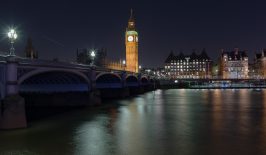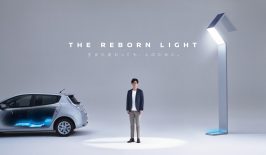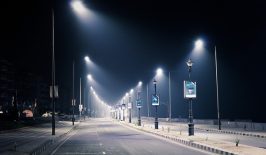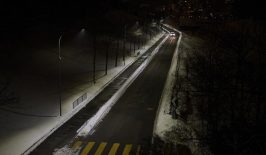Street lighting clearly plays an important role in our towns and cities, but it comes at a cost. Not only does artificial light create light pollution, but the energy that conventional street lights consume – burning for hours throughout the night – also contribute to cities’ carbon footprints. This issue is compounded by the fact that some street lights on quieter roads may not be actually benefiting anyone at certain times of night, but are simply left on.
To tackle some of these issues, University of the Arts Berlin design student Tobias Trübenbacher has developed a wind-powered, motion-activated street light which aims not only to save energy but also create a better environment for urban biodiversity – as well as humans.
The lamp, named the Papilio, features a pin-wheel shaped wind turbine consisting of four aerodynamic rotor blades constructed from folded sheet metal. These power a 300-watt generator which stores the electricity in a rechargeable battery. According to the designer, the lamp can generate around 12 volts of electricity at any given time, while the shape of the rotor blades mean they can make use of the complex and changing air flows of urban environments, such as natural currents, wind tunnels created by buildings, and even the air flow of vehicles. Ideally, the Papilio would be mounted three to six metres from the ground, either on a pole or wall mounting.
The generated electricity is then used to power the LED light, as well as a motion sensor which only activates the light when someone is passing. The Papilio could also feasibly be connected to the local network to divert surplus energy to the grid.
In Germany currently, lighting for streets, squares and bridges consumes as much power as around 1.2 million households, emitting around two million tons of carbon dioxide emissions annually. The use of renewable technologies such as wind could help reduce this. However, the Papilio is also designed to mitigate the other side effect of street lighting – light pollution. The light itself is a so-called full cutoff fixture, meaning it is angled straight down towards the ground and doesn’t emit any light upwards, while also emitting an insect-friendly colour temperature of 2,800 Kelvin. Insects often flock to traditional street lights making them easy prey or resulting in deadly collisions.
However, light pollution can also have negative effects on other city dwellers as well. According to Globe at Night, it can affect nocturnal animals, migratory birds and plant growth, while it also adversely impacts humans. Artificial lighting has been associated with disrupting melatonin production which hinders sleep, resulting in fatigue, anxiety, depression and even some types of cancer.
Light pollution also results in ‘skyglow’, the brightening of the night sky over urban areas, which prevents people living in cities from seeing the stars at night. Although perhaps not as important as the other detrimental impacts of light pollution, it also still acts to reduce urban quality of life.
Of course, street lights do also play an important role in our cities, especially when it comes to public safety. Indeed, they may in fact also be less to blame than previously thought for light pollution. In any case, making their designs more efficient and sustainable will certainly have a range of different knock-on benefits.
Currently, the Papilio has been tested at several locations in Berlin, and Trübenbacher hopes that if the design were to be rolled out at scale, it could help turn out our cities into more climate-neutral and sustainable places.
This is not the first time renewable technologies have been applied to street lighting. Street lights that turn off when nobody is around have already been explored before. One small town in Japan is using old EV batteries to power their street lights and solar panels have also previously been used, particularly in rural areas, but they often come with downsides. They are more expensive, susceptible to rain, snow and dust and need to have their batteries replaced. It remains to be seen if the Papilio method can mitigate any of these issues.






